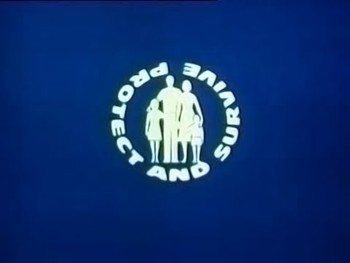
In 1975, at the behest of the British government, Richard Taylor Cartoons (creators of Crystal Tipps and Alistair and the Charley Says public information films) produced a series of animated shorts providing instructions to the general public on how to protect themselves and their homes in the event of a nuclear strike on the United Kingdom. The films were originally intended to air only in the event of a national emergency, but leaked copies made their way to the Campaign for Nuclear Disarmament and The BBC, sparking intense public controversy around the nature and supposed effectiveness of the advice given.
The advice given by these shorts were so spectacularly irrational, contradictory and useless (imagine trying to survive nuclear fallout in a lean-to made from your front door) that they inspired the creation of not one, but two influential films: Threads and When the Wind Blows.
Provides examples of:
- Apocalypse Anarchy: Produced with the aim of avoiding this by encouraging people to remain in their homes since "no place in the United Kingdom is safer than any other".
- Cosy Catastrophe: The shorts seemed to imply that this would be the outcome of a nuclear conflict. Sure, you'd have to stay inside for a couple of weeks, but after that everything would be just fine and dandy. Threads and When the Wind Blows were produced in response. To some degree it actually made sense, because in the 1980s nuclear strategy generally shifted away from attacking population and industrial centers toward attacking enemy military infrastructure (bases, command centers, defense installations, missile silos, etc.) — under the assumption that if enemy military forces are depleted by nuclear attacks, then your conventional military could force him to surrender without resorting to mass civilian casualties. While numerous nuclear explosions around the cities are clearly not good for population, they also clearly much less harmful than nuclear attack against the cities. Still, this would mean mass death to civilians plus destruction of agriculture nonetheless. Though the latter would be naturally less than a direct nuclear attack on civilian centers, it still is something many couldn't survive in the aftermath. Radiation poisoning and the starvation due to crops dying would still kill millions.
- Disposing of a Body: Instructions are provided on what do with a corpse if someone dies while you are confined to your fallout room. You are told to wrap the body tightly in blankets (or whatever you have to hand), attach a label containing the deceased's name and address, and move the body to another room. However, if you have had a body in your house for more than five days, the body should (provided it is safe to do so) be taken outside and buried in a trench or covered with earth, with a marker placed over the grave.
- Emergency Broadcast: Meant to be shown if a potential nuclear war was imminent.
- The '80s: Although produced in the mid-seventies, a Panorama broadcast of leaked footage in 1980 meant that the series went on to be associated far more with the Cold War paranoia of The '80s than of previous decades.
- Every Episode Ending: Each short ends with the logo forming up to the sound of the series' infamously creepy electronic sign-off tune.
